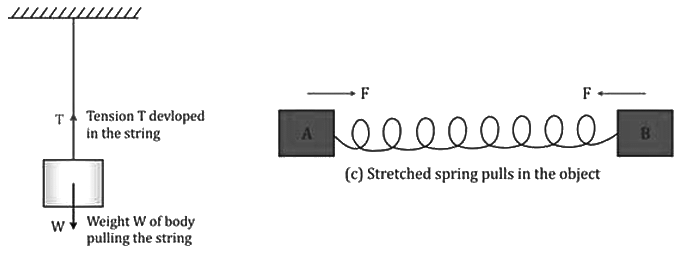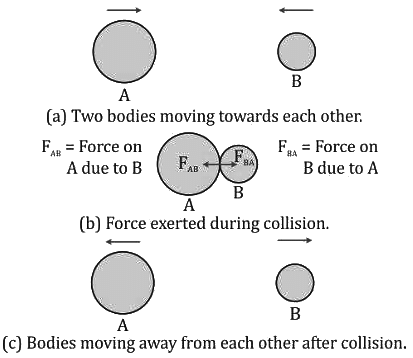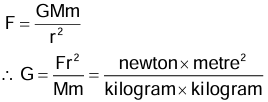Class 9 Exam > Class 9 Notes > Physics Class 9 ICSE > Revision Notes: Laws Of Motion
Revision Notes: Laws Of Motion | Physics Class 9 ICSE PDF Download
| Table of contents |

|
| Kinds of Forces |

|
| Newton’s First Law of Motion |

|
| Newton’s Second Law of Motion |

|
| Newton’s third law of motion |

|
| Force due to Gravity |

|
Kinds of Forces
- Force is a physical cause which changes (or tends to change) either the size or shape or the state of rest or motion of the body.
- The forces which act on bodies when they are in physical contact are called contact forces.
- When a body moves over a rough surface, a force acts on the body in a direction opposite to the motion of the body along the surface of contact. This is called the frictional force or the force of friction.
- When a person moves towards the right on a road, the force of friction acts on him towards the left. This force resists his motion on the road.
- When a body is placed on a surface, the body exerts a force equal to its weight in the downward direction on the surface. However, the body does not move (or fall) because the surface exerts an equal and opposite force on it, which is called the normal reaction force.
- When a body is suspended by a string, the body pulls the string vertically downwards due to its weight. In its stretched condition, the string pulls the body upwards by a force which balances the weight of the body. This force developed in the string is called the tension force T.

- The spring has a tendency to return to its original form. Similarly, when one end of a spring is kept fixed, the spring is found to exert a force at its other end which is directly proportional to the displacement, and the force exerted is in a direction opposite to the direction of displacement. This force is called the restoring force.
- When two bodies collide, they push each other. As a result, equal and opposite forces act on each body.

- The forces experienced by bodies even without being physically touched are called non-contact forces or forces at a distance.
- In the Universe, each particle attracts another particle because of its mass. This force of attraction between the particles is called the gravitational force.
- The force on a body due to the Earth’s attraction is called the force of gravity. It causes the movement of the body towards the Earth, i.e. downwards, if the body is free to move. The body also attracts the Earth by an equal amount of force, but no motion is caused in the Earth because of its huge mass.
- Two like charges repel, while two unlike charges attract each other. The force between the charges is called the electrostatic force.
- Two like magnetic poles repel each other, while two unlike magnetic poles attract each other. The force between the magnetic poles is called the magnetic force.
General Character of Non-contact Forces
- The gravitational force is always of an attractive nature, while the electrostatic force and the magnetic force can be either attractive or repulsive.
- The magnitude of non-contact forces on the two bodies varies inversely as the square of the distance of separation between them. It decreases with an increase in separation and increases as the separation decreases.
Newton’s First Law of Motion
- Newton’s first law: If a body is in a state of rest, then it will remain in that state, and if the body is in a state of motion, then it will continue moving with the same velocity in the same direction unless an external force is applied on it.
- The property of an object by virtue of which it neither changes its state nor tends to change the state is called inertia.
- A force is that external cause which tends to change the state of rest or the state of motion of an object.
Mass and inertia
- Mass is a measure of inertia of the body. Greater the mass, greater is the inertia, and thus, more is the resistance to the change in the state of rest or motion.
Kinds of inertia
- Inertia is of two kinds:
(a) Inertia of rest: If a body is at rest, then it will continue to remain at rest unless an external force is applied.
(b) Inertia of motion: If a body is in a state of motion, then it will continue to move at the same speed in the same direction unless an external force is applied to change its state.
Linear momentum
- The force required to stop a moving body is directly proportional to the mass and velocity of the body.
- The momentum ‘p’ of a body is defined as the product of mass ‘m’ and velocity ‘v’ of the body.
p = mv - If a body is at rest, then its momentum will be zero.
- Momentum is a vector quantity.
- The SI unit of momentum is kg.m/s.
Change in momentum
- Change in momentum is
Δp = mΔv - The rate of change of momentum is
Rate of change of momentum = (Change in momentum /Time)=
- Thus, the rate of change of momentum is the product of mass and acceleration.
Newton’s Second Law of Motion
- The acceleration produced in a body of a given mass is directly proportional to the force applied on it.
a ∝ F - The force needed to produce a given acceleration in a body is directly proportional to the mass of the body.
f ∝ m - Thus,
F = ma - The SI unit of force is newton (N).
- One newton is the force which when acts on a body of mass 1 kg produces an acceleration of 1 m s−2 .
1 newton = 1 kg x 1 ms-2 - The CGS unit of force is dyne where1 newton = 105 dyne .
Newton’s second law in terms of rate of change of momentum
- The rate of change of momentum is a product of mass and acceleration.
Δp/Δt = ma - However, force is a product of mass and acceleration.
- Thus,

- Newton’s second law: The rate of change of momentum of a body is directly proportional to the applied force and takes place in the direction in which the force acts.
Newton’s third law of motion
- Newton’s third law: To every action, there is an equal and opposite reaction.
- In an interaction of two bodies, there are action and reaction forces present. The action and reaction forces act on two different bodies.
Universal law of gravitation
- This law was given by Newton.
- Universal law of gravitation: Every object in the universe attracts every other object with a force which is proportional to the product of their masses and inversely proportional to the square of the distance between them.
f ∝ Mm/(r2)
∴ F= GMm/(r2)
G is the proportionality constant and is known as the universal gravitational constant. - The universal gravitational constant G is independent of
- The medium between the two bodies
- The masses of the two bodies
- The distance of separation between the two bodies
Universal gravitational constant G

- The SI unit of G is Nm 2/ kg2.
- The value of G is G = 6.67 x 10-11 N m2/kg2.
- The gravitational constant is defined as the force of attraction acting between two masses each of mass 1 kg placed at a distance of 1 m from each other.
Force due to Gravity
- The force with which the Earth attracts an object is called the force due to gravity.
- If we consider a body of mass m = 1 kg, then the force due to gravity is

- Thus, we can say that the Earth attracts a body of mass 1 kg with a force of 9.8 N.
Acceleration due to Gravity
- Whenever objects fall towards the Earth under the influence of gravitational force alone, we say that the objects are in free fall.
- The motion of an object under free fall is an accelerated one. This acceleration is known as acceleration due to gravity ‘g’.
- This acceleration is the same for all bodies.
- It is a vector quantity directed vertically downwards towards the centre of the Earth.
g = GM/R2 - Here, R is the radius of the Earth.
- By substituting the values of G, M and R in the above equation, we get

Free fall
- The motion of a freely falling body or a body thrown vertically upwards is a one dimensional motion under gravity.
- If a body is freely falling, then a = g. If it is thrown upwards, then a = −g.
- The equations for a freely falling body with initial velocity u = 0 in terms of g are
v = gt
s = (1/2)gt2
v2 = 2gs - Similarly, for a body thrown vertically upwards with initial velocity u, these equations are
v = u - gt
s = ut - (1/2)gt2
v2 = u2 - 2gs
Mass and weight
(i) Mass
- The amount of matter contained in a body at rest is its mass.
- It is a scalar quantity. Its SI unit is kilogram (kg).
- It does not change with change of place of the body. However, when the speed of the body approaches the speed of light, its mass changes.
(ii) Weight
- The force with which an object is attracted towards the Earth is the weight of that object.
- It is written as W = mg . Its unit is newton (N).

Gravitational Units of Force
- One kilogram force is the force due to gravity on a mass of 1 kilogram.
1 kgf = 1 kg x acceleration due to gravity g in m s-2
= g N
= 9.8 N - Similarly, one gram force is the force due to gravity on a mass of 1 gram.
1gf = 1g x acceleration due to gravity g in cm s-2
= g dyne
= 980 dyne
The document Revision Notes: Laws Of Motion | Physics Class 9 ICSE is a part of the Class 9 Course Physics Class 9 ICSE.
All you need of Class 9 at this link: Class 9
|
9 videos|74 docs|10 tests
|
FAQs on Revision Notes: Laws Of Motion - Physics Class 9 ICSE
| 1. What are the main differences between mass and inertia? |  |
Ans.Mass is a scalar quantity that measures the amount of matter in an object, while inertia is the property of an object that resists changes in its state of motion. In simple terms, mass is a measure of how much stuff is in an object, and inertia describes how that object behaves when forces are applied to it.
| 2. What is Newton's second law of motion in terms of momentum? |  |
Ans.Newton's second law states that the force acting on an object is equal to the rate of change of its momentum. Mathematically, it can be expressed as F = dp/dt, where F is the force, p is the momentum, and t is time. This means that the greater the force applied to an object, the greater the change in its momentum over time.
| 3. How does the universal law of gravitation explain the attraction between two masses? |  |
Ans.The universal law of gravitation states that every point mass attracts every other point mass with a force that is directly proportional to the product of their masses and inversely proportional to the square of the distance between their centers. The formula is F = G(m1*m2)/r², where G is the gravitational constant, m1 and m2 are the masses, and r is the distance between their centers.
| 4. What is free fall and how does it relate to acceleration due to gravity? |  |
Ans.Free fall refers to the motion of an object under the influence of gravitational force only, without any other forces acting on it (like air resistance). During free fall, all objects accelerate towards the Earth at a constant rate of approximately 9.81 m/s², which is known as the acceleration due to gravity.
| 5. What are the different kinds of inertia? |  |
Ans.There are three kinds of inertia: inertia of rest, inertia of motion, and inertia of direction. Inertia of rest is the tendency of an object to remain at rest unless acted upon by a force. Inertia of motion is the tendency of an object in motion to stay in motion at a constant velocity unless acted upon by a force. Inertia of direction refers to the tendency of an object to continue moving in a straight line unless acted upon by a force.
Related Searches















